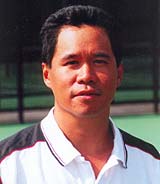|
TennisOne Lessons Racquet Head Speed on the Backhand Doug Eng EdD, PhD Years ago the backhand was considered to be a neutralizing shot. It was rarely used as a weapon. Today the backhand is a powerful weapon for many club players, juniors, and touring players alike. Many players today have a two-handed backhand which gives them the added benefit of racquet head control and consistency. Relatively rare by modern standards, even some one-handed backhands can be tremendous weapons. Today’s lighter racquets allow the backhand drive – traditionally less powerful than the forehand – to be an explosive shot. Let’s look at three techniques you can utilize to help turn your backhand into a weapon by adding racquet head speed. First is rotation of the upper body. Second is the use of the high loop in the backswing (These two techniques can work with either the one-handed or two-handed backhand). The third is the wrist break which many two-handed touring pros use. Even if you already have sufficient power, you might be able to add a bit more using some of the techniques discussed here. Rotation
In the modern backhand, rotation of the upper body can really ignite a powerful swing. Think of how a baseball player at bat waits at the plate. The batter’s shoulders turn away from the pitcher who can see the numbers on the back of the hitter. In Figure 1, we see Ana Ivanovic and Michael Llodra showing the chin-on-shoulder turn. Note how extreme their rotation is; the back is turned so that it is about 25-40 degrees from being parallel to the net. Note also that Ana’s head and eyes are turned towards the ball as she focuses.
We can see rotation in two areas, the hips and the shoulders. The closed stance both players are using allows the hips to close away from the net. The yellow lines in Figure 1 show that the hips are turned about 30-40 degrees from parallel to the sideline. The green lines show the shoulder rotation. Due to the photo angle, it appears that Llodra’s rotation is greater than Ivanovic’s. In any case, there is an additional 15-30 degree more rotation between the shoulders and hips. Hence, there are two things you can do: close off the hips with a slightly closed stance and create a separation angle between the shoulders and hips. To get a bit of extra shoulder rotation, make sure your front shoulder drops slightly so it can rotate under the chin. The extra shoulder turn and upper body rotation allows you to use the larger core and back muscles to create power and angular momentum to drive the racquet forward. Note, this is a pre-requisite for developing racquet head speed not the source of racquet head speed itself. It is a part of what is known as loading in the preparation phase of the swing. Loading is the temporary accumulation of energy or power to be used as the racquet accelerates on the forward swing.
High Loop Swing In Figures 4 and 5, we see Elena Dementieva and Richard Gasquet in a stop-footage video that shows a high loop in the backswing. The red line traces the racquet head tip through the backswing until contact with the ball. The high backswing allows a greater shoulder turn and more potential energy into the ball. Keep in mind that Gasquet is probably an extreme example but often it is helpful to see such an example since it gives us a clear picture of how far one can go. Note that one-handers and two-handers can both use the high loop backswing.
On the one-hander, to get the high backswing, rotate your upper body and shoulders a bit more than normal using the non-dominant hand to support the racquet up high. You can see Michael Llodra (in Figure 1) use his right hand to set up high. For the two-hander, as you turn, set the non-dominant hand just above the dominant hand which creates a more vertical racquet angle. That would be similar to holding a baseball bat upright. The high loop backswing sets the racquet higher which can get more potential energy (i.e., potential energy of an object is proportional to the height of the object). It also makes the racquet path considerable longer than if you swing straight.
Look at either Gasquet’s or Dementieva’s backhand loop. Watch how far the tip of the racquet head travels. The red curved lines in Figure 4 and 5 show the length of the actual swing (using the tip of the racquet head) from the backswing loop to the contact point. The yellow line represents a straight (or small loop) backswing. Note that the yellow line has a 2-4 feet shorter path than the high loop backswing. If Richard took a straight backswing, his racquet backswing would be more compact. It is harder to get as much racquet head speed with the more compact swing since acceleration must be greater over the shorter distance. Some players can get great racquet head speed with the compact swing but many others cannot. By using a high loop backswing, Gasquet increases his racquet swing by about three feet. That gives him more distance and time to build racquet head speed.
A large loop isn’t favorable for control on fast-paced balls such as defensive groundstrokes or return of serves. In those cases, it is better to keep the backswing more compact. However if you have time, using a high loop backswing can give you a bit more offense on the backhand. We normally associate a high loop backswing with the forehand but clearly there are some players who also use this style of backswing on the backhand. The one-handed backswing needs the high backswing loop to create power. It also allows one to use slice or underspin instead of topspin since it is a natural high to low swing. Some two-handers don’t use a high backswing but get plenty of power since they use another final action which we will now discuss. Wrist Break That last action on the two-handed backswing is the wrist break. Elena Dementieva doesn’t really rely on a wrist break since she uses a high loop backswing which increases the racquet path and potential energy (with the racquet starting in a high position).
Many players with two-handed backhands, however, are comfortable with more compact and lower swings. Therefore, they can’t use the loop to generate racquet head speed. Instead they use a cocking action in the wrist much like a left-handed forehand. If the non-dominant hand is used to generate power, it sets the wrist in an extended position on the backswing. In that case, often the dominant hand is in an awkward position and must either let go or break in the wrist. In Figure 7, we see Venus Williams who doesn’t use a high loop backswing. Instead, she sets the racquet lower by the hips in her unit shoulder turn. By flexing her right wrist, she allows the non-dominant hand to point the racquet butt to the ball. The wrist break can occur on either low or high backswings. On the high backswing, the racquet makes a C motion and drops into a position below the ball. At this lowest point, the wrist can break. On the low backswing, the wrist break position is more important for generating racquet head speed.
In Figures 8 and 9, Ana Ivanovic and Gael Monfils are shown in the wrist extension position and near contact position. At far left in Figure 8, in her forehand, Ana’s wrist is laid back or extended. The racquet butt faces the ball due to the wrist position. She then accelerates the racquet head to contact so the racquet moves from parallel to the sideline to parallel to the baseline. Note the arm or body doesn’t move as significantly. Compare that with the two images at the right which show Ana’s backhand. In the third from left image, Ana’s backhand is shown with the left wrist cocked. The racquet butt again faces the oncoming ball and the racquet is approximately parallel to the sideline. When the butt of the racquet faces the ball with the wrist cocked, one can maximize racquet head acceleration. This racquet position (first and third photos in Figure 8 or 9) is called the slot. And in the far right, we see the racquet near contact and parallel to the net.
In Figure 9, we see Gael Monfils in basically the same sequence. Note that in the forehand, the right wrist is in a cocked or extended position. On the backhand, the non-dominant hand uses wrist extension to cock the racquet so the butt faces the ball in the slot position. That creates the wrist break in the right or dominant hand. I show the forehand and backhand for both Ana and Gael for comparison. In the two-handed backhand, the hands are often set closer to the body. That forces the non-dominant hand into an awkward position where the wrist must flex or break. If you set the racquet even lower and closer to the body, the dominant wrist will naturally break more. If the racquet is set higher and farther away from the body, the dominant wrist won’t break as much.
In addition, if the dominant hand is more to a forehand grip it will break more but if more to a backhand grip, it will break less. Figure 10 shows the different grips. Note the right (bottom) hand grip changes from an eastern forehand, to continental and finally to an eastern backhand. Moving over, in that order, will decrease the tendency for the wrist to break. In Figure 11, we see Anna Chakvetadze hitting a backhand. She uses a high loop backswing unlike Venus Williams (in Figure 7). Her swing is farther away from her body which reduces the wrist break action. What is important is not really the wrist flexion on the dominant hand but that it allows the non-dominant wrist to extend and lay back similar to the forehand. That drops the racquet into the slot position and helps facilitate acceleration needed to drive the ball with pace and topspin.
Practice this wrist extension by swinging a forehand with your non-dominant hand. Make sure your non-dominant wrist extends or lies back so the butt faces the net. Take some practice swings, then try putting your dominant hand on the racquet and you will see how the dominant wrist should break if you are to keep a similar swing motion. Conclusions Here we see three ways of increasing racquet head speed. Together they work well in synergy although some players, as Venus Williams shows, don’t use the high backswing. Of course, that doesn’t mean she can’t generate power. Instead, it is a combination of body parts that make the swing powerful. This combination is known as the kinetic chain which involves coordination of the legs, core, shoulders, and arms to work together to create the best shot possible. Each body part is like a link in the chain. Your timing of these links is important to develop powerful strokes. So the next time you get out on the court, use timing and these techniques and feel the power! Your comments are welcome. Let us know what you think about Doug Eng's article by emailing us here at TennisOne.
Doug Eng EdD PhD coaches men's tennis at Tufts University. During the summer, he directs at the Tennis Academy at Harvard. He has received four divisional Pro of the Year honors from the PTR and USPTA and several national awards including PTR Tester of the Year. Doug is a member of the USTA National Sport Science Committee. He completed the USTA High Performance Coaches program and frequently runs educational and training programs for coaches. |
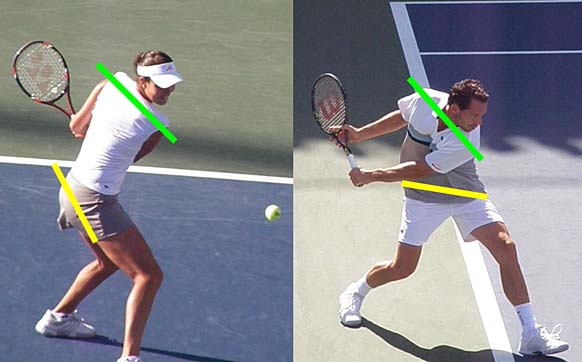
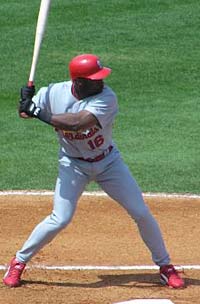
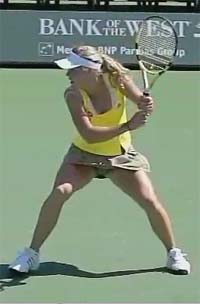
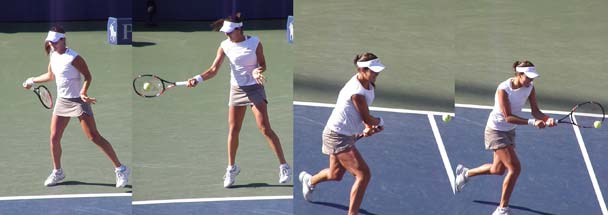
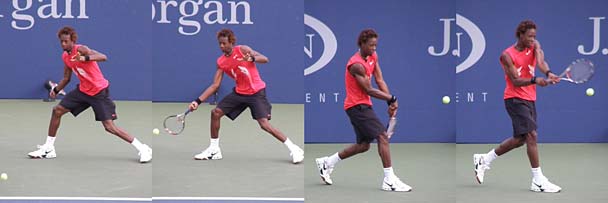
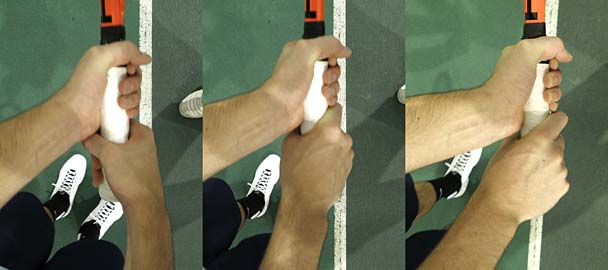 FIGURE 10. Two-handed backhand grips.
FIGURE 10. Two-handed backhand grips.